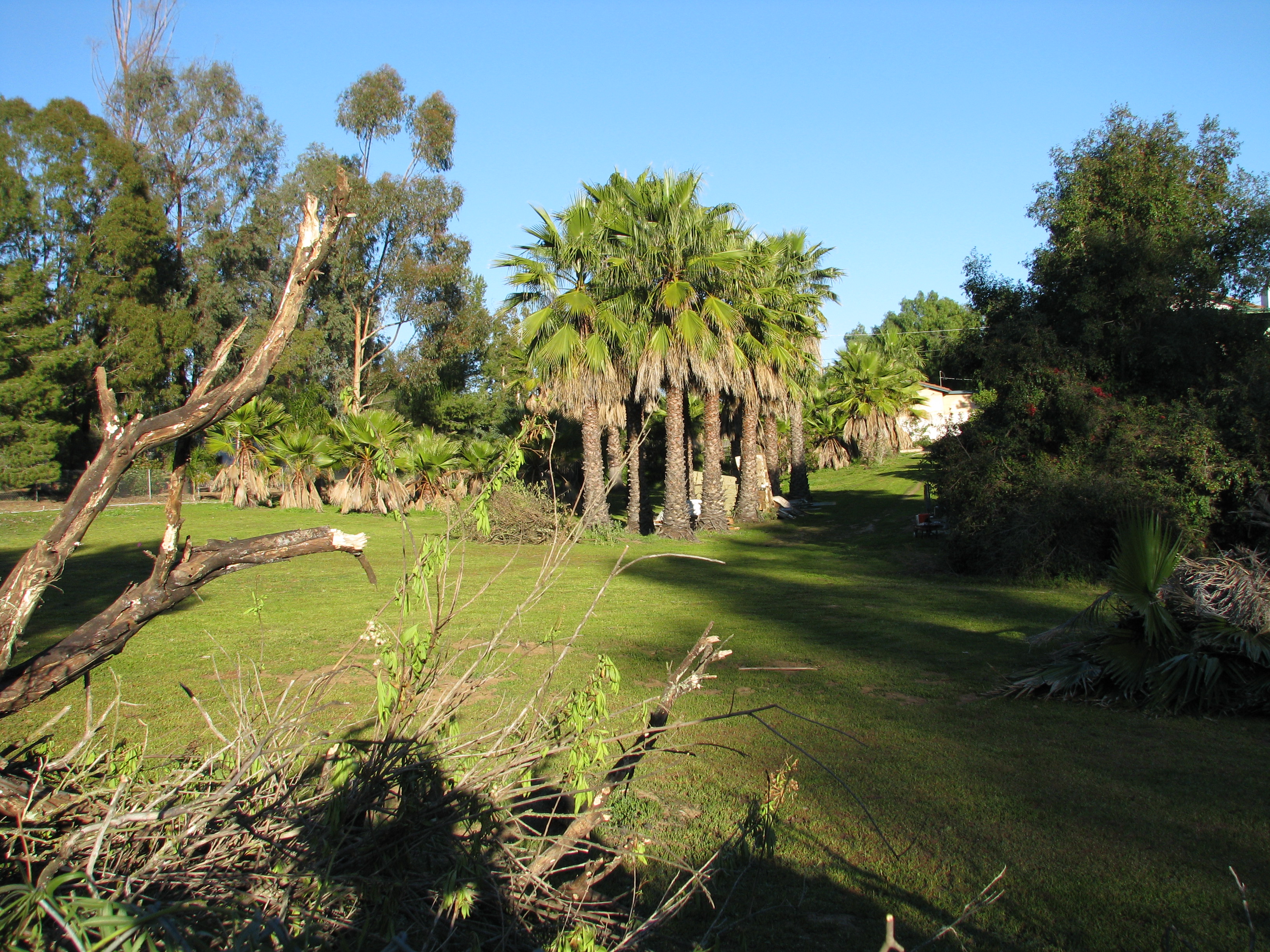-
Good-bye, Sweet Belle: The Death of a Crossbill Hen

Belle in her bath. Last Tuesday when I opened the chicken tractor to let the girls come bounding and clumsily flutter out for their breakfast, Belle our genetic crossbill Americauna didn’t emerge with her usual energy. I make a custard of blended chicken food, whole eggs, greens and fruit, cooked and cooled, to feed her. The custard contained all the goodies the other hens had, but was easier for her to scoop with her twisted beak. I’d fill her dish before I come down to ‘do the hens’, and she was fed first. Her dish was placed into the top of the quail hut with the door propped open so only Belle coud get in and out; the other hens loved to share her food otherwise.
Although Belle ate vigorously, she never gained full body weight. Her beak prevented her from eating well enough. Out of every five scoop attempts at the custard I’d say that she’d get one mouthful. Yet she was always perky, always running around interested in everything, and even tried dominance tactics over some of the other girls. They’d let her since she wasn’t a threat to any of their food.
Because Belle’s eating habits were very messy her neck and head feathers were straggly, and combined with her twisted beak gave her a comical, slightly crazed look. Because she was handled so much when she patiently allowed us to trim her beak and nails, and give her a bath, she was very friendly. She’d jump on our backs and shoulders any time we’d bend over in the coop. She’d enjoy being carried around. She was very spoiled. We’d read posts where owners of crossbills, who didn’t cull them but kept them as pets, had them live up to ten years and lay eggs. It was all dependant upon to what degree their bills crossed, and Belle’s became severe.
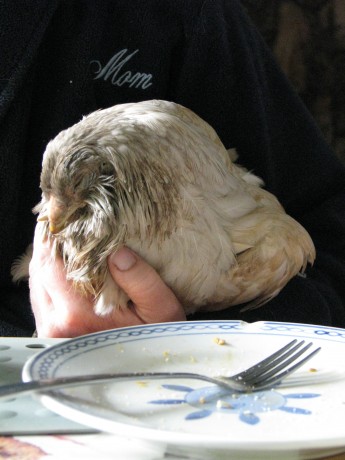
About a month ago we noticed mites on her, something that is common on hens, and gave her a good bath and treatment with food grade diotomaceous earth. The FGDE works immediately and is very effective and safe. Otherwise she was bright, fun and perky, burrowing under the other girls on the roost overnight to cuddle.
Tuesday Belle was slower to come around, and didn’t want to eat. A hungry hen not wanting to eat? Bad news. We immediately took her into the house. It was a cold day, so we made her comfortable next to a space heater. On inspection we discovered that she had mites all over her. We also checked the other hens right away and they were all okay, so apparently Belle’s diminishing health encouraged them to reproduce, and as she couldn’t groom herself she was stuck. We coated her with FGDE, not wanting to bathe her while she was feeling poorly since it was a cold day, and dropper fed her food. She showed some energy and wanted to run around, and took the food hungrily.
It was time to trim the Christmas tree, and my daughter put Belle under her sweater to keep her warm and comforted as we worked; Belle loved being cuddled and held, so she put up no resistance, but we could see that she was ill.
We brought in the cage that we used for Viola the ex-house chicken, and for all of our patients, and tucked Belle in for the night next to the space heater.
In the morning Belle was sitting very still. I knew that she was nearly gone. Just after waking my daughter, Belle died as she held her. She is buried outside our bay window where we watch birds, close to the house.
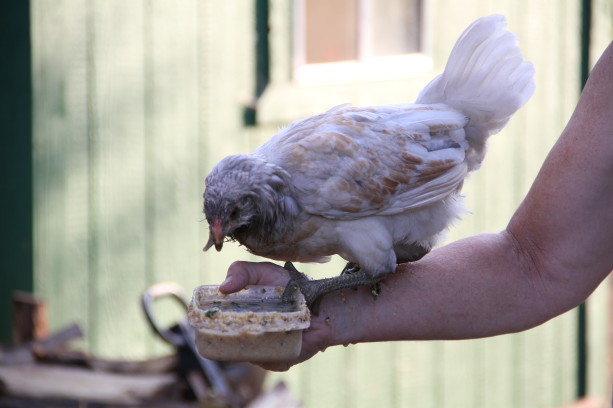
Belle usually can’t wait until she’s served. Birds are so tricky. They can seem perfectly fine, but when they show illness it is usually too late and the end comes quickly. There is little you can do for them besides keep them comfortable. Neither of us expected Belle to pass away; she showed no previous symptoms and was her usual plucky, fun self. Something internal gave way from slow malnutrition caused by that darned crossed bill and her inability to eat enough. On reflection I don’t think that Belle had a bad life. She ate enough to not be hungry all the time, and her custard gave her ease of eating. She was much loved and spoiled. Her end was quick, which was merciful and not granted to many of us. But Belle will always be remembered.

Ah haz a friend! - Arts and Crafts, Gardening adventures, Humor, Permaculture and Edible Forest Gardening Adventures, Water Saving
Remodeling the Outdoor Sink
I’m thrilled with my outdoor sink. I love it. It is my friend. It is my old kitchen sink, stubbornly hauled around the property until I finally was able to put it on an old fishtank stand and hook it into the waterline out in the garden. Even better, Steve, who used to work here and who was responsible for the Mock Pavilion, modified the stand so that the sink fit down into it more securely. Any water used would be caught in buckets underneath (with long sticks in them so that any creature that falls in can crawl out again), which I would pull out and empty.
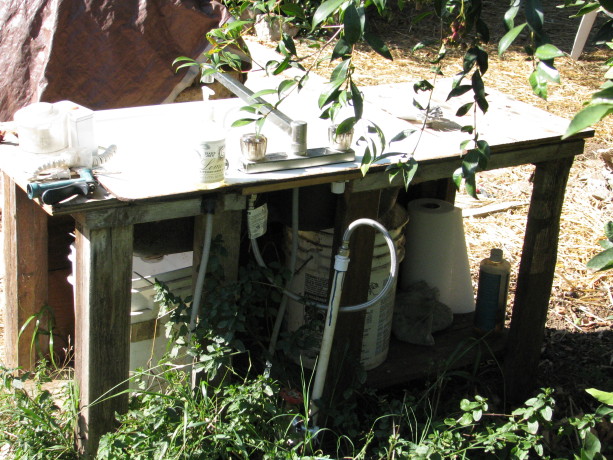
The buckets are just another heavy thing with which I had to deal. There had to be another way. A problem with the sink being set down into the stand is that the underside of one of the drains now sat slightly into a bucket, so I’d have to tip the bucket to get it out. Wrestle it out would be the better term, usually becoming wet with old sink water in the process. Throwing a 5-gallon bucket of water somewhere lost its charm quickly, especially as I was the only one emptying, but not the only one filling. Something had to be done. When I made the area next to the Fowl Fortress into an apple tree guild, I now had an area which could use extra water. The sink needed to be moved. Last week I finally did it, and I have to say, I’m pretty smug about how.
I am a disaster with a saw, but I’m pretty experienced with old PVC pipe and Red Hot Blue Glue (all those sprinklers I’ve mowed down over the years). I leveled a place next to the coop and placed some old plywood on it, both to help steady the sink stand and to keep weeds down (and to use up the plywood).
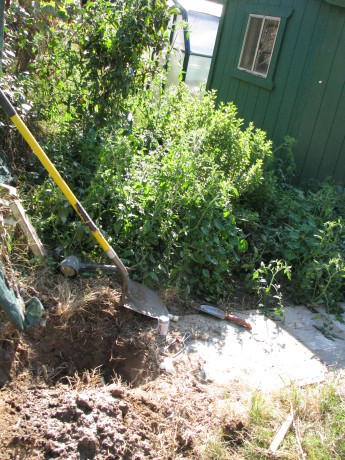
I dug up the water line and placed plywood on a leveled area. I dug up the water line, turned off the irrigation water, opened other faucets to drain and then cut into the pipe. Then I discovered the real pipe beneath this old dry one, and dug it out and cut into it, allowing it to drain as well before connecting a tee.
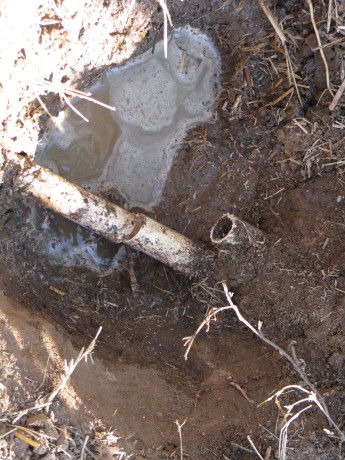
Beneath the old pipe was the real one. The hens were all pressed against the side of the coop trying to see what I was doing, and desperately wanting to search for bugs in the dirt I’d just dug up. Sorry girls.
I laborously walked the rather heavy and unevenly weighted stand (the sink isn’t in the center) over to the plywood. Then I walked it off again, adjusted, and walked it back. Then I adjusted again. Then I had a sit-down and wondered what my chiropractor was going to say.
Now came the fun problem-solving part. The drains from the sink were open, so how to catch water and send it off into the guild, without spending a bunch of money? The vision came to me from out of the blue: plungers. Some people have visions of how to earn lots of money, others have visions of how to change the world for the better. My imagination provides me with plungers. Yep.
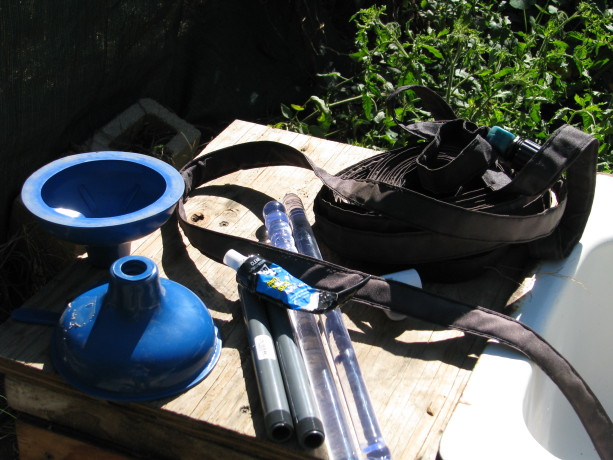
Supplies. I learned from my collegiate daughter, and the hardware store cashier, that plungers were nicknamed ‘magic wands’. No matter how much I learn each day, I’m always in the dark on the important things. However, I felt pretty proud of myself and was excited to get started. I rooted through my barrel of old PVC left from the former owners (I’ve lived here over 14 years and the PVC was already old then) and through my fittings. I only needed a couple new fittings and the plungers from Joe’s Hardware. The plungers had blue cups and clear handles, not the wooden-handled, black-cupped manly plungers of my imagination. If wizards had plungers, I could see them using these. Well this would be a female version and blue is my favorite color.
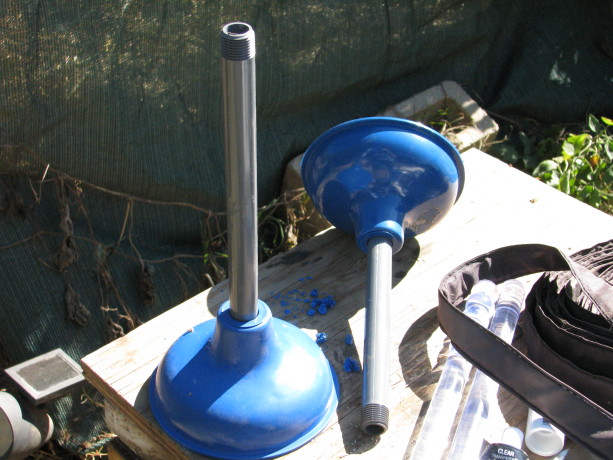
I screwed in threaded 1/2″ risers and tried them as is, but they leaked, so I put silicone gel around the threads and tried again. It worked after the gel dried. Knowing that the thread of the plunger handle wasn’t the same thread as a PVC riser (how do I know these things? Am I channeling some long-dead plumber??) I grabbed silicone sealant I had recently purchased to seal up leaks in a small fountain so that it would work during garden tours (the sealant worked, but then the motor failed. Sigh.)
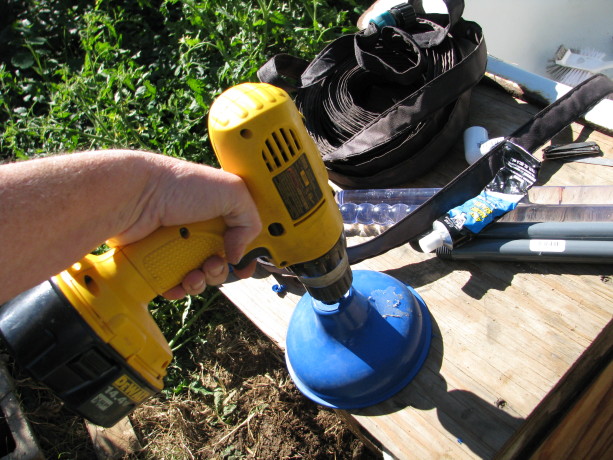
Drilling drain holes in the plunger cups. I had expected to find plunger heads and handles sold seperately, and remembered seeing plungers with threaded holes all the way through. I must have been flashing back to the cheap supplies offered to the parks department when I was a Ranger because all I found at Joes were complete, and the holes were covered (better suction). I drilled through the rubber to make the drain hole (which created some very cute blue rubber curls).
I connected up most parts, but then came the challenge, to space the plungers the correct distance apart, and measuring is not my thing. It seems simple, but it never works for me. My ginko must have kicked in, though, because I realized that I could just place the plungers over the sink holes on top and build it up there, and of course it would be the correct distance underneath.
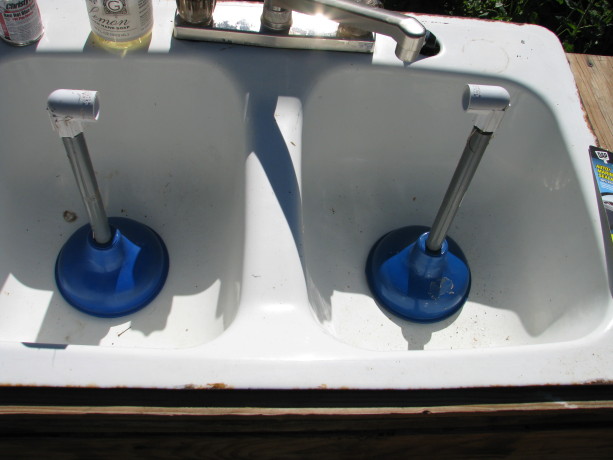
Ha! I didn’t have to lay in the tomatoes and work around the legs in the back! I could do it on top and still get the length right. I’m still proud of figuring that out.
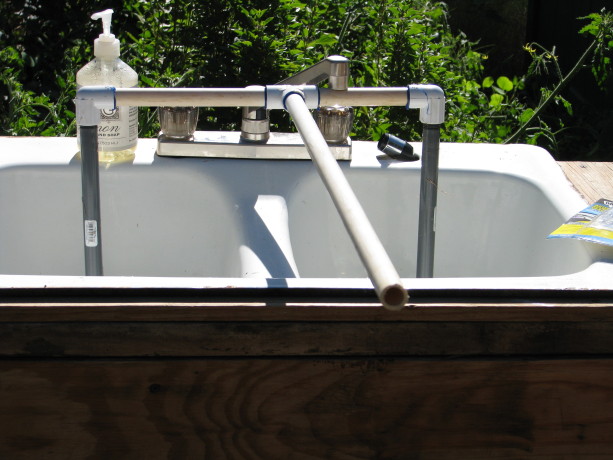
All ready to go. The trick really was to get this thing in place around the support legs behind the fishtank stand! 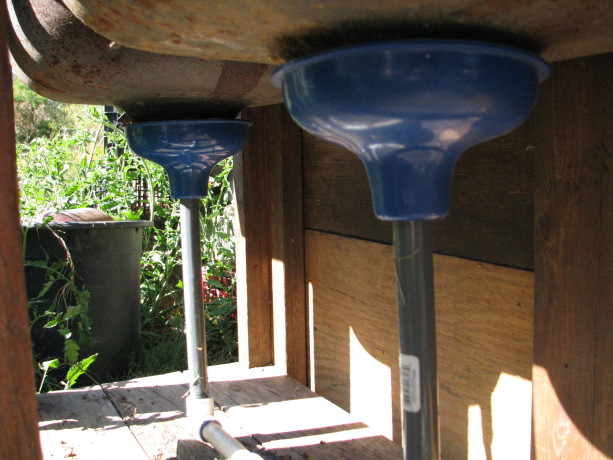
My beauties. My plan was to screw it into a soaker hose that I already had, but I worried that without water pressure it wouldn’t work. It didn’t.
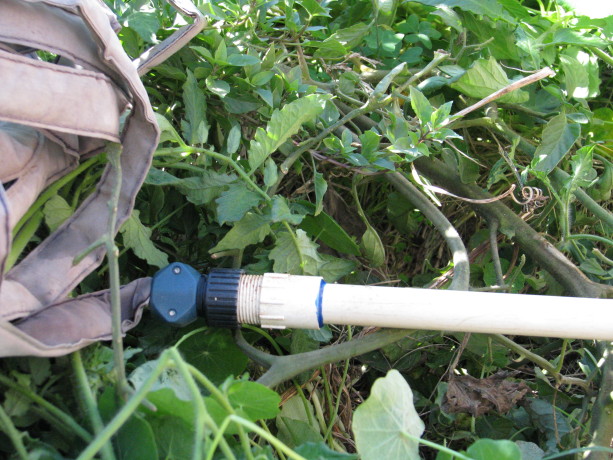
The soaker hose idea failed because of the lack of water pressure, and caused the water to back up and overflow the plunger cups. I removed the screw end from the PVC and glued on more 1/2″ pipe so that the water would directly empty near the apple tree.
There were a few other tweaks, such as widening the drill holes in the plunger for better water drainage, propping the pipe up on a piece of wood so that it fit the drains more securely (it isn’t fastened onto the stand so that if I had to access the plunger cups I could do so easily), and placing screen over the drains so no one would lose a ring down into the device.
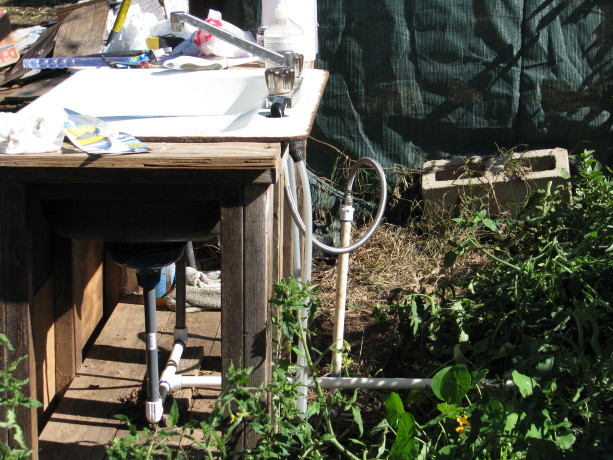
Now the water drains directly into the bed. Tip: glue the long pieces on once the main part is in place under the sink. Plants will grow up around the back of the sink to hide it from view. Now it all works, I have less work to do, no yucky buckets to haul, the apple tree receives greywater, I repurposed several items and although I had to buy a few things, I supported a local business, the sink is in a better location, and I like the blue color of the plunger cups.
Best of all, now I have some snazzy clear handles to use for some other project!
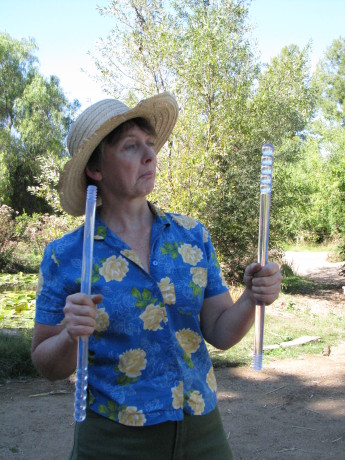
Hmm. Threaded magic wands! I wonder how I can repurpose these beauties?! - Animals, Gardening adventures, Hugelkultur, Natives, Other Insects, Permaculture and Edible Forest Gardening Adventures, Ponds
Then and Now
This photo was taken just as work was begun on transforming the property into a garden, in February, 2011.
This photo was taken last Thursday, Oct. 31, 2013, from the same location.
This view may look weedy, especially in the early morning light on this brilliant Halloween morning. What you are seeing is the first bog, which is the green spot in the foreground. The dirt area is the overflow, if torrential rains ever come again. To the left, the tall bushes constitute the withy hide, and to the left is the big pond, although you have to take my word for it. Tall bamboo arches over the stumps of the palm trees in the above photo, which are trellises for roses and other vines. A nectarine branch is in the right foreground. The tall flowering plants are a native called fleabane. They reseed readily, and I allow them to because of several reasons. They grow five to six feet tall and help shade smaller trees and plants against the harsh summer sun, protecting them from sun scald. They also die off in the winter, making good hugelkultur material. The purple flowers, which are in the above photo now turning into fuzzy seed clumps, are attractive. The most important thing though is that they are excellent hosts for native insects of all kinds. Ladybugs, lacewings, spiders, and hundreds of tiny wasps and flies, many of which are parasitic, all love these flowers. All summer long they are alive with life. Inviting in the native pollinators, and growing a polyculture garden, is the first line of defense in growing naturally.
Allowing nature to define parts of your garden leads to happy surprises and lots of help from unexpected friends, such as bugs, birds and lizards. This kind of garden is endlessly interesting, with new things to study every day.
The following photos were all taken the same brilliant morning, Oct. 31, 2013. Here in San Diego county we were having what is called a Santa Ana, where warm, dry winds from the desert blow westward, as opposed to the more humid eastward flow of air from the ocean that we normally have. Santa Anas can bring heavy winds and make tinder-dry weedy hills a fire hazard, but this year we’ve been lucky and no major fires have happened. We even had almost 3/4 ” of rain, last week, which is practically unheard of for October. The warm Autumn sunshine was intense and lovely, and I had to take photos even though the light was too strong for good ones.
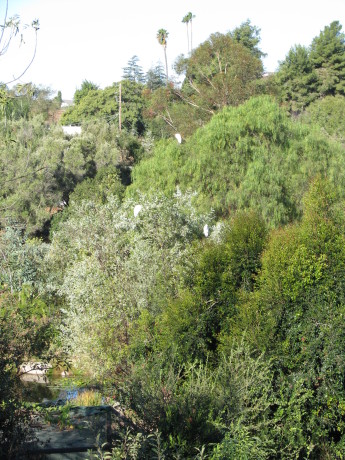
We went up on the roof to view these three greater egrets perched in our trees over the pond. 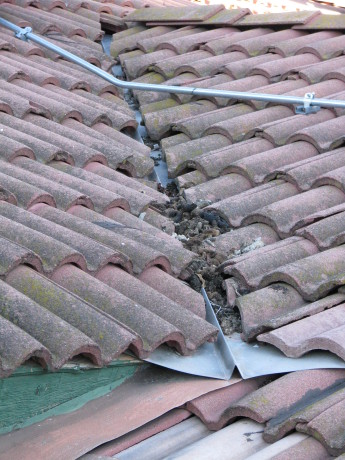
Being on the roof is an education. Here is lots of racoon poo between the tiles. Why?! 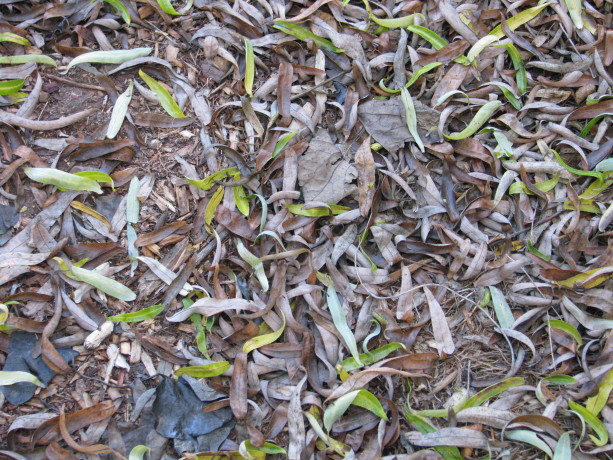
We don’t have dramatic Fall colors here, but the subtle Autumn hues of leaves is lovely. 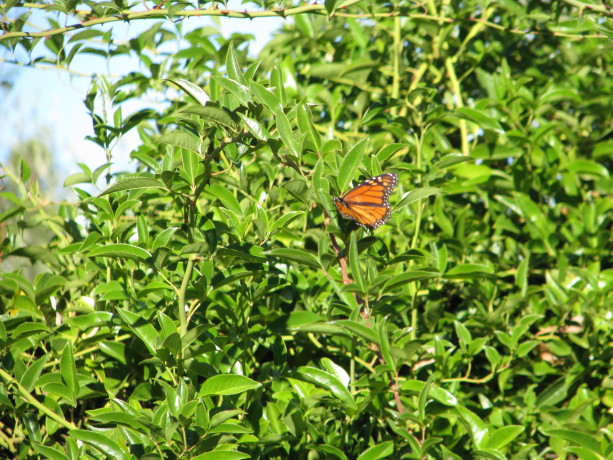
We still have Monarch butterflies. 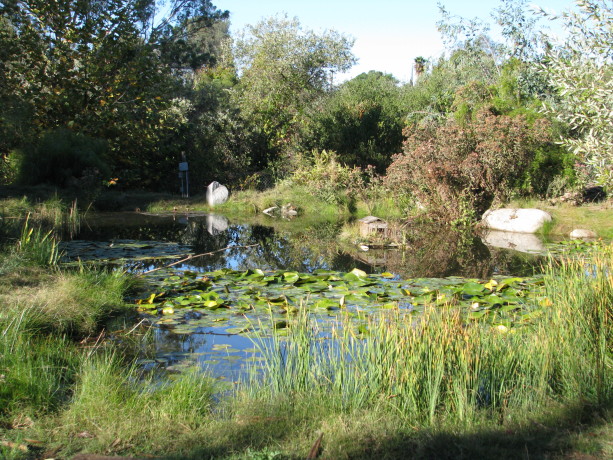
The big pond in early morning light. 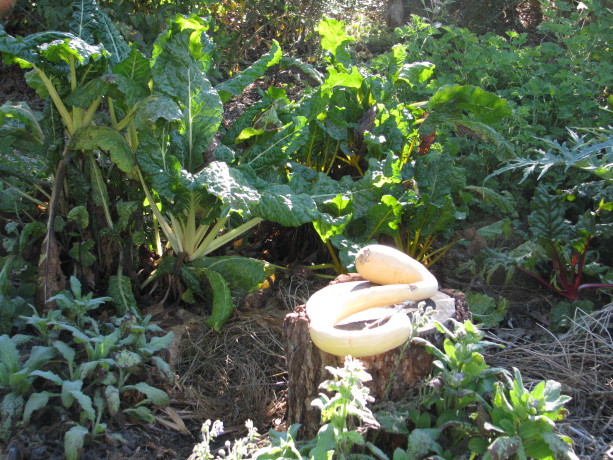
A zuchianno rampicante reclining on a stump. (Its a squash!). 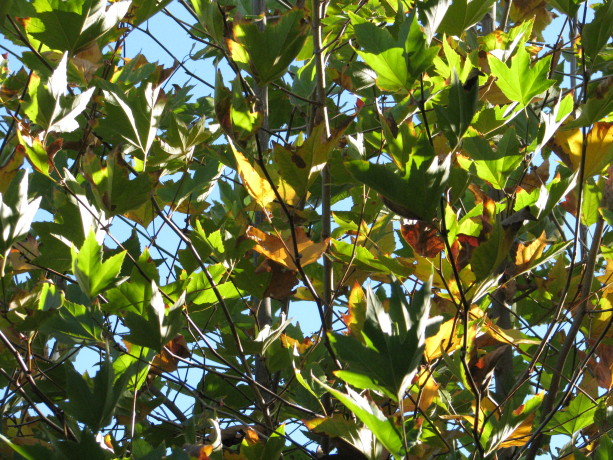
Morning sun through a Fall-leaved sycamore. Beautiful. 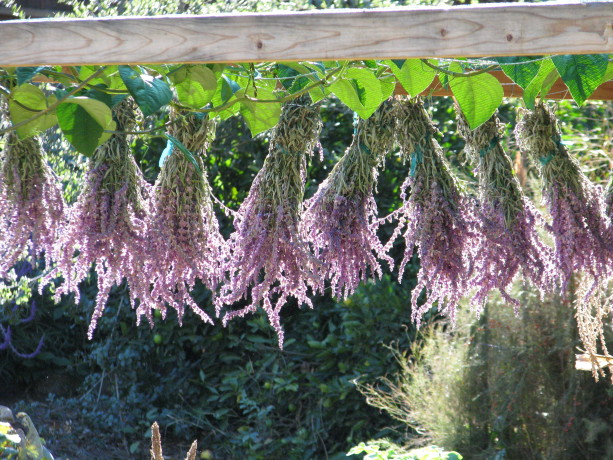
Mexican bush sage hanging up to dry. 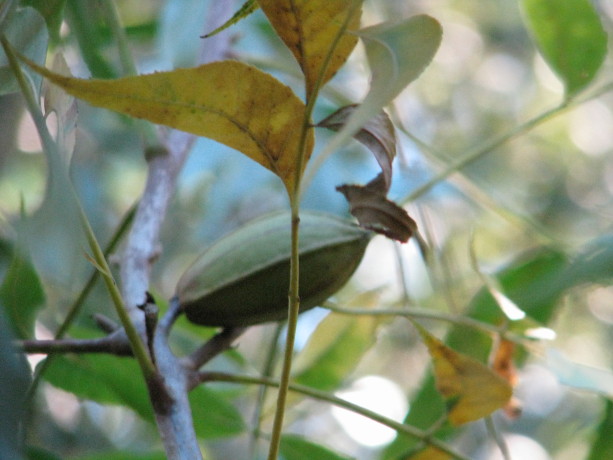
Our little pecan tree put on about six this year! Next year, tons! 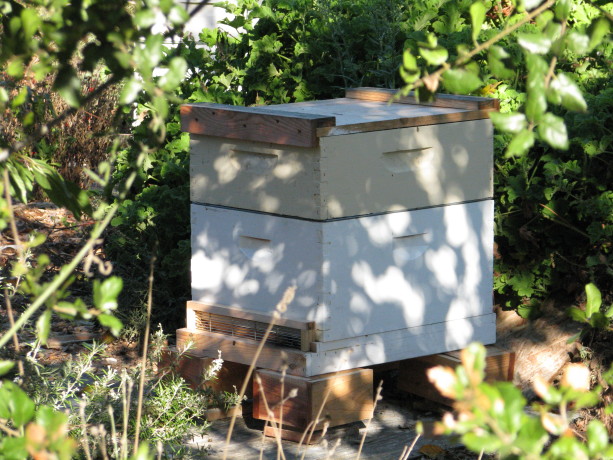
Beehive warming up. 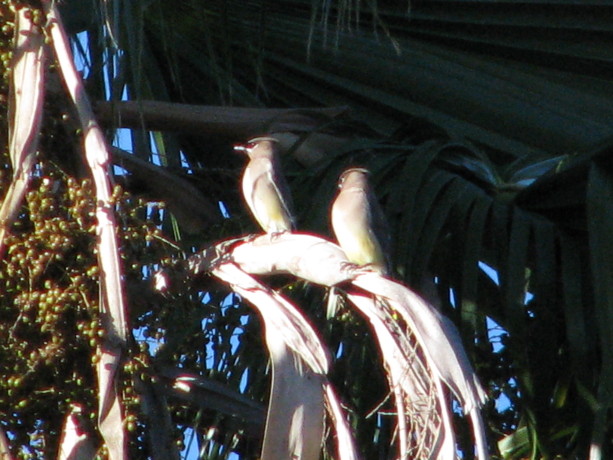
Ceder waxwings (my favorite bird) in the big palm. 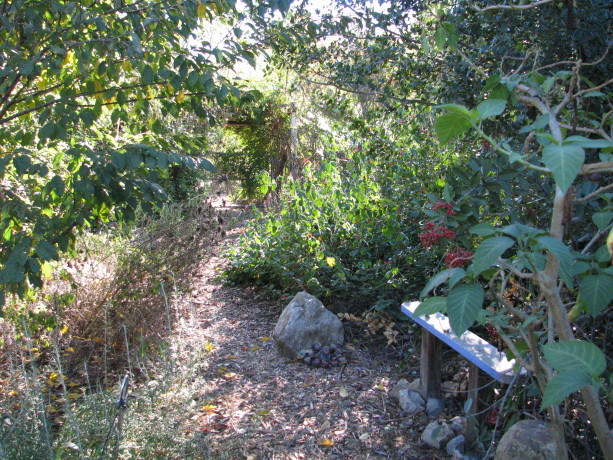
The Bee Garden. 
The liquidambers, also known as sweet gums, are just beginning to turn color. Lots of deciduous trees means lots of leaf mulch, and more warmth reaching the ground during the winter. 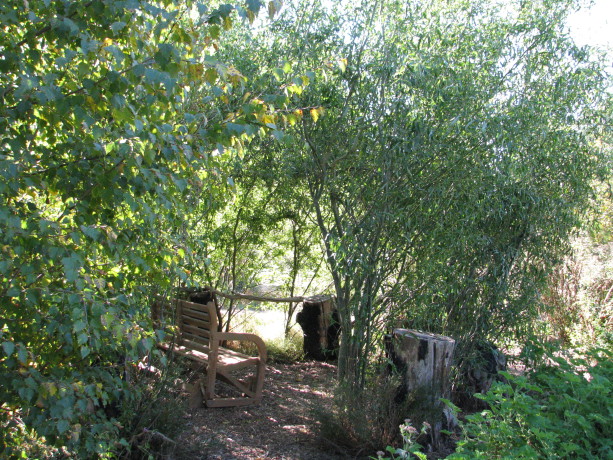
The entrance to the withy hide, with the pond in the distance. 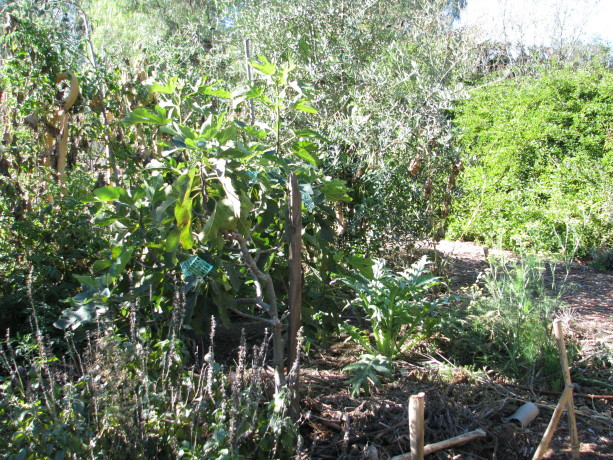
The Mission fig,with artichoke, anise and sage.. 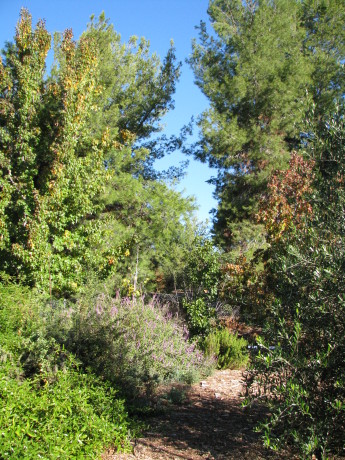
The canopy is growing. 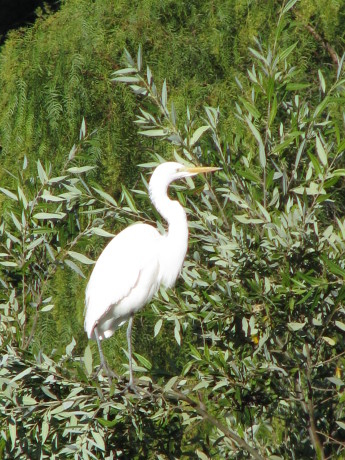
Greater egret enjoying the sun. - Animals, Chickens, Cob, Compost, Composting toilet, Fruit, Gardening adventures, Giving, Grains, Health, Herbs, Houses, Hugelkultur, Humor, Living structures, Natives, Natural cleaners, Permaculture and Edible Forest Gardening Adventures, Ponds, Rain Catching, Recipes, Seeds, Soil, Vegan, Vegetables, Vegetarian, Worms
San Diego Permaculture Convergence, Nov. 9 – 10, 2013
There is a fantastic, information-packed permaculture convergence coming up at the beautiful Sky Mountain Institute in Escondido.
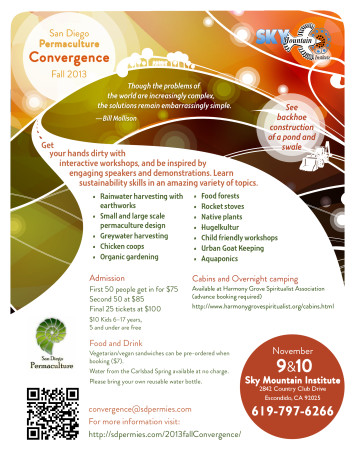 It will be two days packed with great information for a very reasonable price; in fact, scholarships are available. Check out the website at convergence@sdpermies.com. On that Sunday I’ll be teaching a workshop about why its so important to plant native plants, how to plant them in guilds using fishscale swales and mini-hugelkulturs. Come to the convergence and be inspired!
It will be two days packed with great information for a very reasonable price; in fact, scholarships are available. Check out the website at convergence@sdpermies.com. On that Sunday I’ll be teaching a workshop about why its so important to plant native plants, how to plant them in guilds using fishscale swales and mini-hugelkulturs. Come to the convergence and be inspired! - Gardening adventures, Permaculture and Edible Forest Gardening Adventures, Recipes, Vegan, Vegetables, Vegetarian
Dinner with the Pandas: Harvesting Your Own Bamboo
Hello.
Before you cry, “Imposter!”, let me assure you that I have authorization to be here. Mostly. I happen to be Diane’s daughter Miranda, guestblogging and wordsmithing for you today. You might recognize my powdery feet or recollect me when keeping company with chickens (or from diverse other adventures). As much as I enjoying rolling in dust and home decorating with hens, today I’m here to talk about an unusual topic for Vegetariat – food.
The handy rhyme isn’t the only reason I’m sometimes known as Miranda the Panda – I also have a great partiality for a bit of bamboo, much like the vegetarian carnivore from whom I draw my catchy moniker. Luckily, we happen to have a fair bit of the stuff around Finch Frolic these days (bamboo, not pandas). Bamboo shoots are a common – and delicious! – component of Asian cuisines, and bamboo has been used for many culinary purposes, such as flavoring rice, wherever it grows. During this past summer, I was overcome with the need to find more things to eat on the property and began a foray into harvesting our own bamboo shoots.
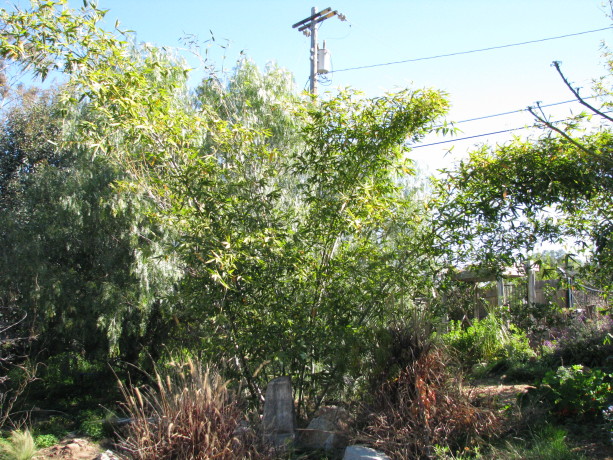
Our giant species of bamboo arches over many of our paths — perfect for building material, and any shoots that venture into the soil of the paths are prime targets… 🙂 Before I stepped outdoors and started gnawing on the nearest clump, I had to be sure that our bamboo is an edible variety, and hopefully a tasty edible variety. You need the scientific name of your bamboo for that, but once we ferreted out ours (Bambusa beecheyana), it was easy to find notation of its edibility and delectability online. One helpful and extensive listing is on Guadua Bamboo. Happily, there is a large number of edible and tasty bamboo species.
Proof of mange-ability in hand, the next obstacle was divining the best way to get bamboo shoots from the ground to my mouth. Harvesting can be more or less of a challenge, depending on what variety of bamboo one has and how it’s established (e.g., moisture and soil conditions, obstacles like stones around it). To harvest shoots, it’s best to pick fat green ones poking no more than a foot above the ground. You want to catch them before they get too woody, but old enough to have a bit of meat on them, so to speak. The shoot is mostly leaf (tightly layered sheaths), so bulkier shoots are more rewarding.
Removing our bamboo from the ground and its parent plant turned out to be on the more side of challenging.
Miranda and Diane bust out the Finch Frolic arsenal on the recalcitrant shoot.
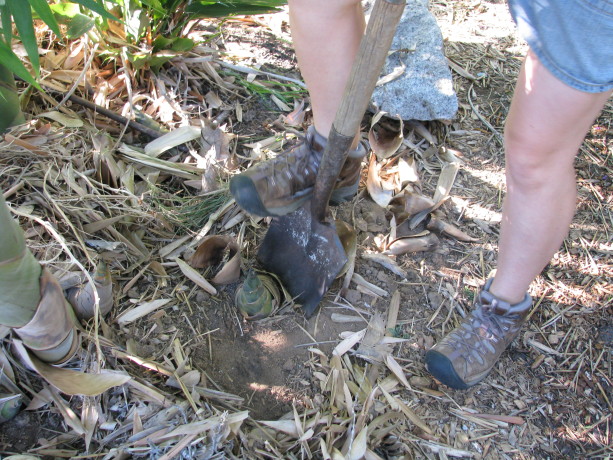
First, the inimitable spade is set to the task. 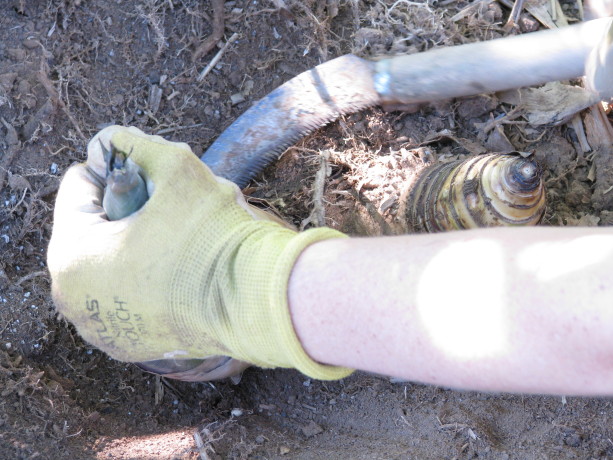
Legs weary and spade abandoned, the small sickle saw is recruited, to little effect. Diane had just returned home and gleefully plunged into the fray, skirt, white sandals and all.
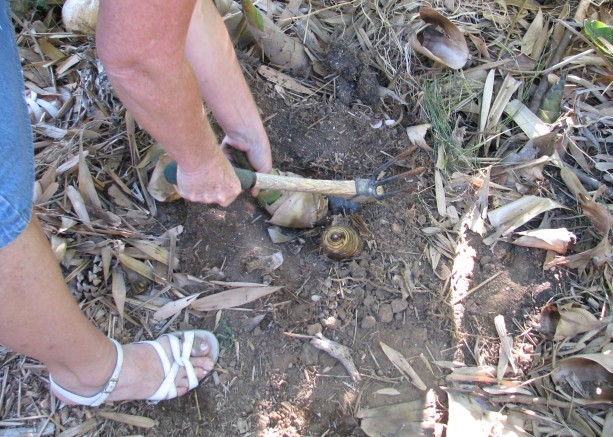
Finally, Diane wades into battle with the winning implement. 
The shoot, freed from the earth and its parent plant. Once we finally achieved success, processing could begin! It is somewhat tiresome to strip a shoot down to the edible white core, because the leaves cling so tightly and are fibrous. It’s like shucking the most stubborn ear of corn in the world. It’s good to slit the tougher outer leaves with a very sharp knife and peel them away.
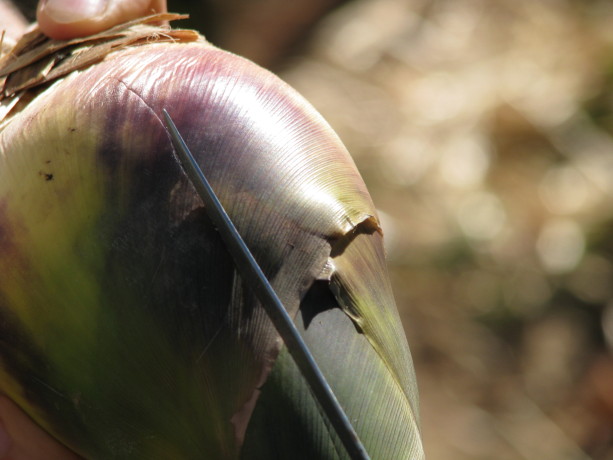
Slitting the fibrous outer leaves with a filet knife. 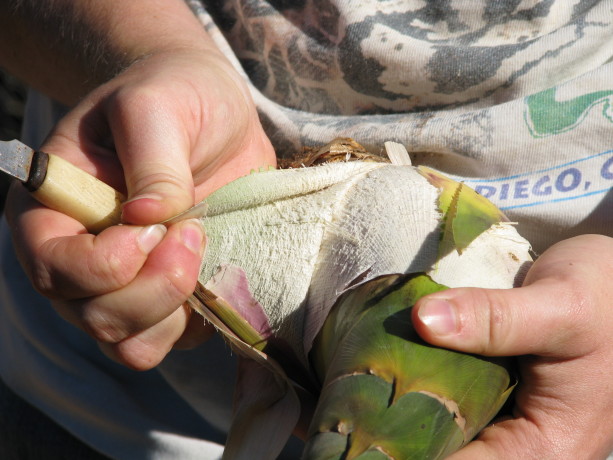
Peeling. The inner leaves come away more easily – rather like the layers of canned hearts-of-palm – as you get closer to the heart of the bamboo shoot. The innermost leaves are basically fetal, and so are edible because they haven’t gotten tough yet. They make the tip of your shoot look hairy.
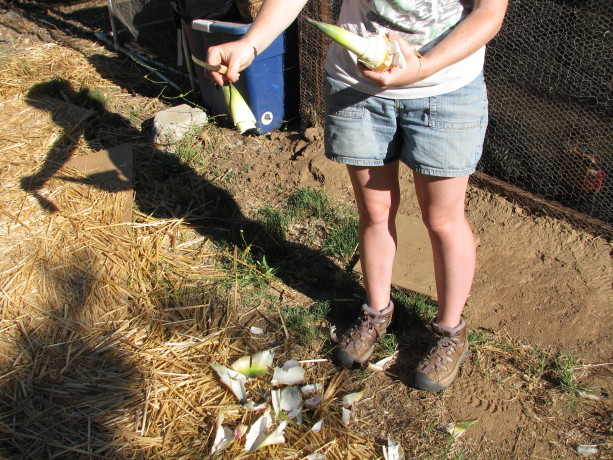
Many layers of increasingly tender leaves. 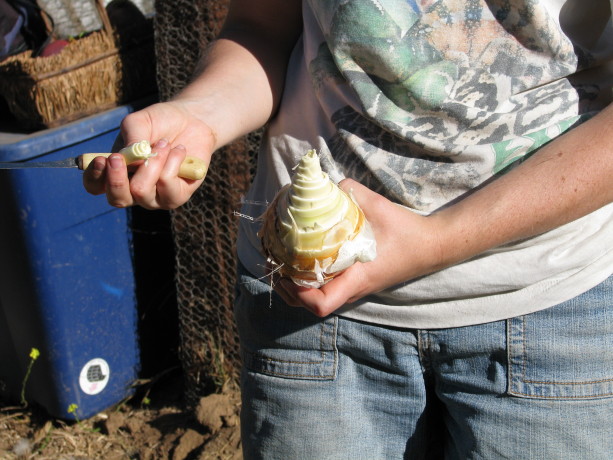
The edible shoot. A peeled bamboo shoot can be cut up in whatever way the chef desires. The shoot grows more fibrous towards the base, where there is probably some inedible hard material. My current rule of thumbs-carefully-tucked-away is if a sharp knife can pretty easily get through it, it’ll be fine to eat.
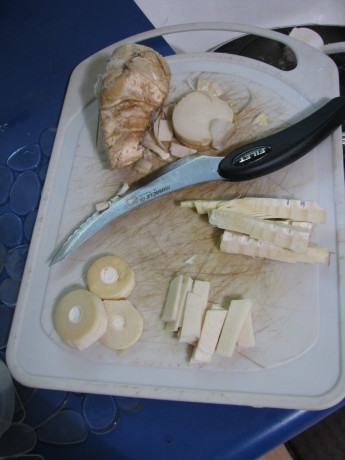
A shoot cut in three different ways. The material behind the knife (upper left) is too fibrous to eat. You just have to boil your slices before cooking and consumption because they contain a mild toxin that dissipates with boiling. The first time, we tried boiling in lightly salted water for only 30 minutes, and while the shoots were tender and not really bitter, they left a teeny tingling sensation in our mouths, like stir-fried Pop Rocks. The last time I cooked them, I boiled them for a whole 50 min. to much more satisfactory, un-tingly results.

Boiling to remove toxins. Bamboo is delicious and a lot of fun (in a somewhat laborious way) to harvest. The beauty of harvesting your own bamboo shoots is that you are saving yourself a trip to specialty markets and controlling your bamboo’s growth at the same time!
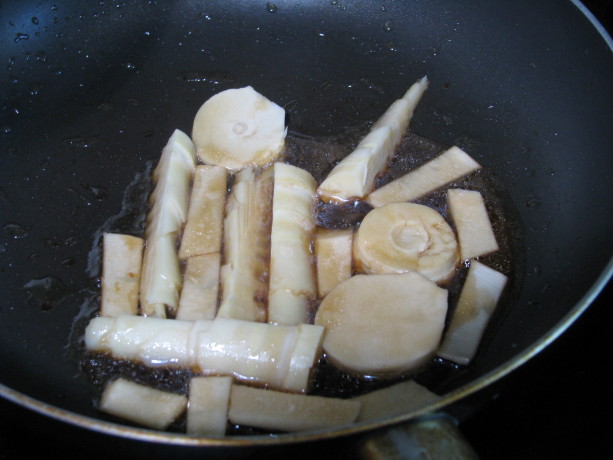
Frying up — yummy! So that’s another thing going on here at FFG. Thanks for wandering the bamboo lane with me.
TTFN!
Miranda (the Panda), B.S.
-
Tiny Hugels and Fishscale Swales: Small water catchment
In permaculture it is recommended to design long level, contoured swales throughout your property to catch rainwater. Long swales, however, won’t work when the property is small, or if it is already mostly planted, or if the hiring of large equipment or teams of diggers isn’t feasable, or if long swales aren’t part of a lovely garden. What then?
In the gardens for which I’ve written consultations I’ve recommended what Geoff Lawton (of the Permaculture Design Institute of Australia) calls fishscale swales. Small curved swales staggered up a slope so that rainwater can be caught and held. One overflows into another, just like a pinball machine.
Any swale, no matter how small, will help hold water. I put them in just above each plant, the width of the dripline of the plant. I also combine them with burying wood (hugelkultur). I don’t have a lot of branches or logs, but I do have a lot of extra pieces of lumber salvaged when the sheds were dismantled. These pieces are untreated (no paint or pressure treatment), and if they have nails and screws in them, even better! The hardware will mineraize the soil as it decomposes. This wood is already very old and dry, and thus will soak up water a treat. If you soak the wood in water, compost tea or a microbial brew before you bury it, that’s super. If not, don’t worry about it. The idea is that rainwater will accumulate in the swale, percolate into the soil and into the wood below it. There the wood will hold water as it breaks down, gradually irrigating and fertilizing the plant below.
Wood can be placed on top of the soil and buried as the swale is dug, or it can be dug into the ground and covered. The swale is filled with mulch o help retard weed growth; if by a walkway the scale filled with mulch then it may be walked on without fear of a twisted ankle.
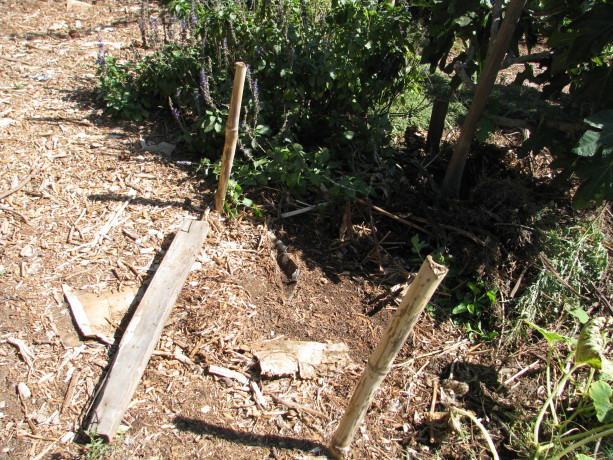
This area right above the fig is small, but large enough to catch water. Here I have a Mission fig that has been slow to grow due to irregular watering (NOT my fault!)
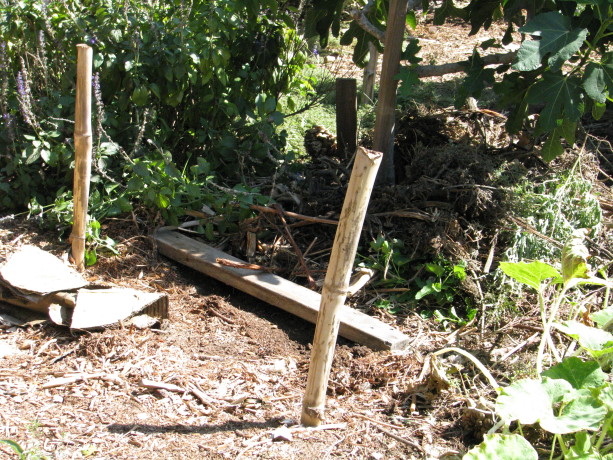
I laid out a board right on the ground. Figs like a little water and this area has been on the dry side. In the direction from which rainwater would flow, above the tree, I laid out a few pieces of old lumber, nails and all.
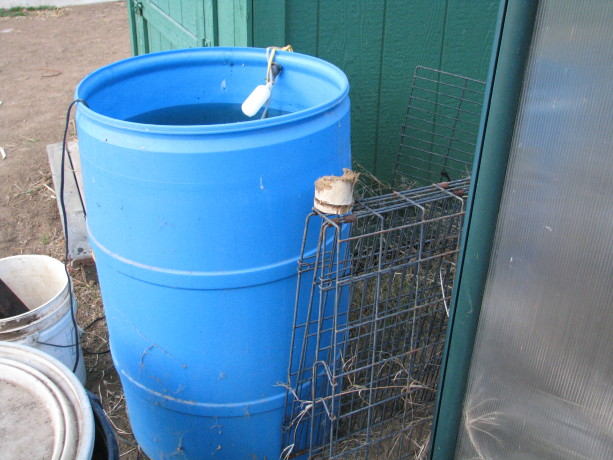
Brewing microbial tea. I happened to be brewing a large batch of microbial tea, so I threw the wood into a bucket of the stuff and let it absorb some.

I soaked the wood in microbial tea for a few minutes. They happen to be the width of the existing dripline of the tree; again, any swale and and wood will help. I dug a small swale the same length, a shovel’s width wide, and threw the dirt on top of the wood.
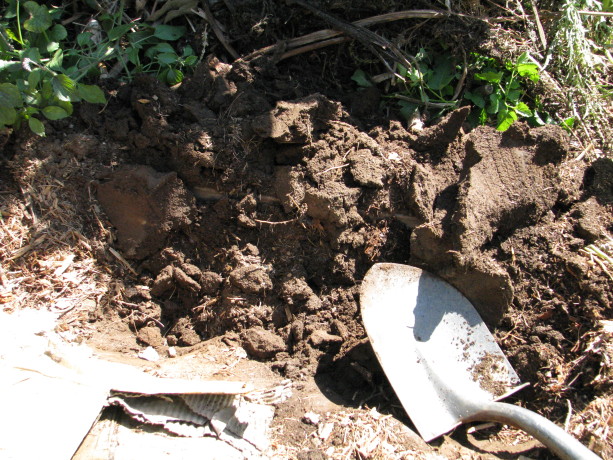
I dug a swale, using the dirt to cover the board. Then I filled the swale with mulch and voila! the job is done. This will now catch rainwater, hold moisture, and fertilize the tree, as well as finding something useful for junk lumber. Burying the wood sequesters the gasses released in decomposing materials into the soil rather than the air thus helping reduce greenhouse gasses.
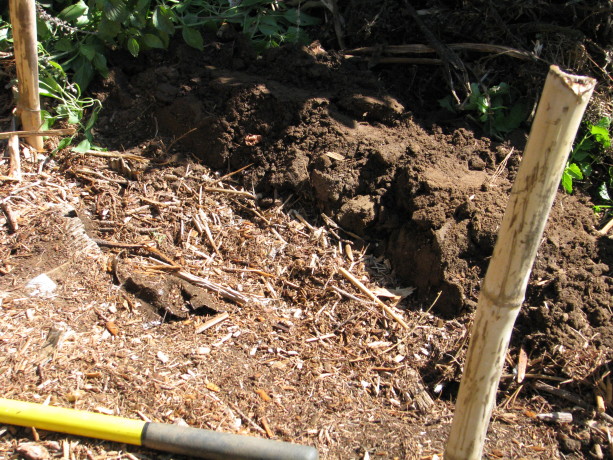
I filled the swale with mulch to keep down weeds. Presto! Done! Using fishscale swales and mini-hugelkultur beds when planting most native plants can really help them become established in a low-water situation. This wild rose (rosa rugusa) is being planted in a very dry area, and I wanted to bury the wood below soil level to keep it closer to the roots of the plant. I dug a small trench and laid out some boards, nails down.
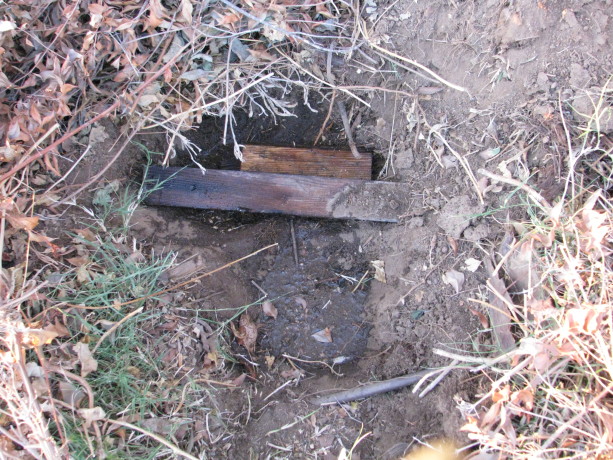
I dug a little ways into the dirt and laid out the soaked wood. Then as I dug the swale I layered the wood with dirt and a couple more boards until buried. I filled in the swale with mulch and planted the rose on the downhill side.
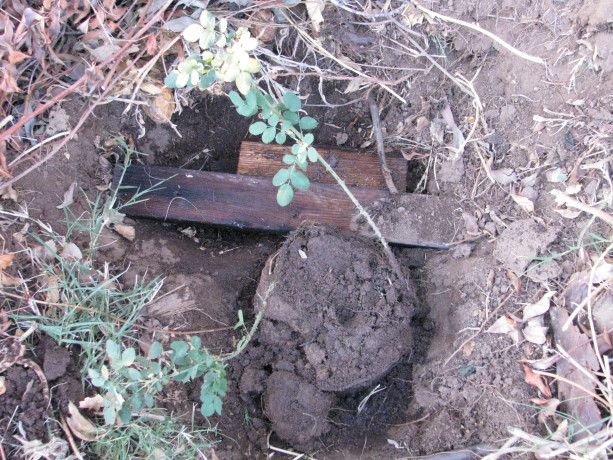
Here you’ll see the rootball of the new wild rose in front of the wood. I threw in some coyote scat since it was lying there so conveniently. There’s quite a microbial boost for the rose!

Some coyote scat went in, too. Sorry! Remember that here in a dry climate we need to plant so that the root ball is even with the ground, or make the whole catch basin a little lower. Otherwise the roots will dry out. Planting so that the root ball is a little above the ground is a common practice is rainy areas.
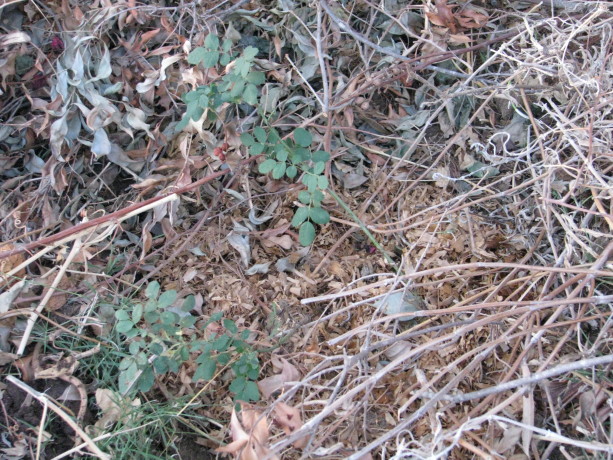
Here is the planted rose, with mulch pulled up around it. Remember native plants have communities. Certain plants grow with certain others because they are mutually beneficial. This rose was planted within the dripline of an Engelmann oak, one place it is found.
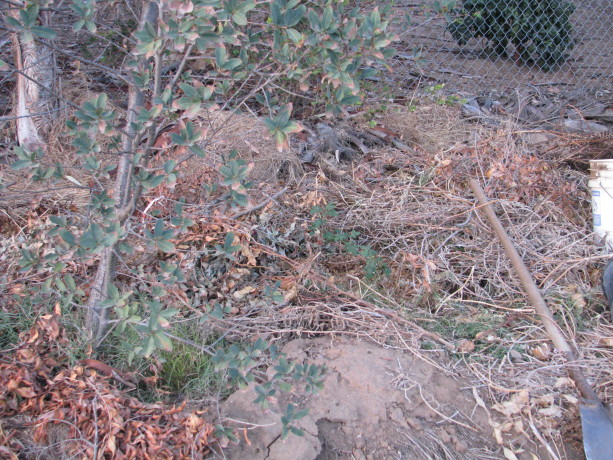
Many native trees like the company of other natives. I planted this rose just outside the dripline of this oak, one of the places it would naturally grow in the wild. So swales don’t have to be gigantic earthworks projects. They can be small and alternated down a slope, or just individual ones above new or existing plants. Throw some wood into a mini-hugel between the swale and the plant and you’ll water less, fertilize naturally, and compost leftover wood. Don’t forget cotton clothing and bedding… that all works, too!
.
-
Belle: Adventures of a Crossbill Chicken

Belle looks much jauntier than she is while being rinsed in her bath. When we added to our flock of five last March by acquiring chicks, we soon discovered that our Americauna (ironically already named Belle), was a genetic crossbill. Crossbill is a genetic mutation found particularly in Americaunas which causes the beak to scissor so that they don’t meet. Some unfortunate crossbills are affected so extremely that the hen eventually would starve to death. Because of the crossbill, the hens can’t peck at food.
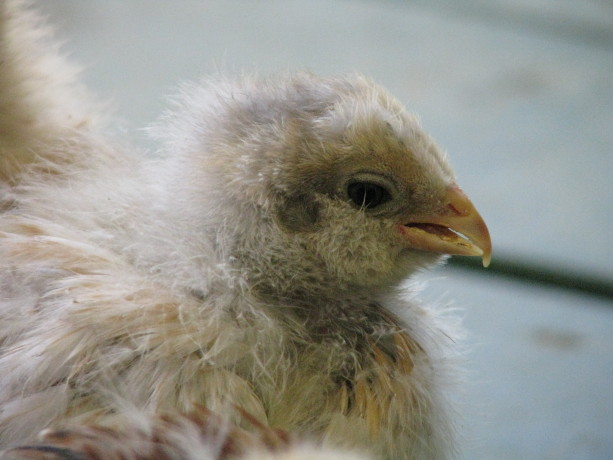
Aww! Belle as a baby. Sigh. So far Belle is able to eat, provided that we give her special food. We also use nail clippers and a nail file to trim as much of her beak off as we can without nipping the wick and making it bleed. Belle is very patient during the process. Mostly.
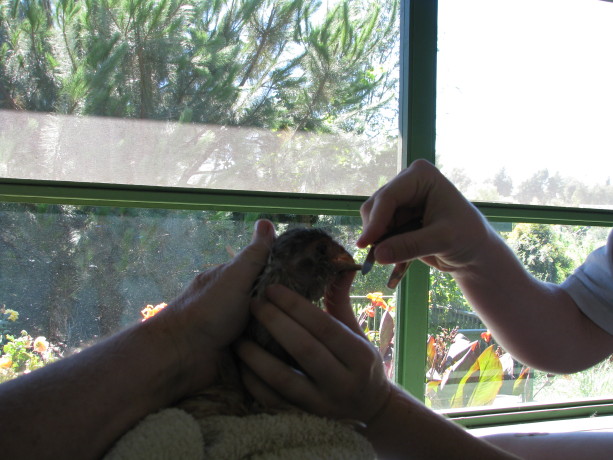
Gently and carefully trimming and filing Belle’s beak, keeping clear of the wick. She also can’t preen well. Preening in hens means that they dip their beak into an oil gland over their tail feathers and smooth that over their feathers, knitting them together and combing out the pin sheaths emergent feather shed as well as dirt and other itchy things.

Grooming is a challenge for her. Here feather sheaths and bits adorn Miranda after we finger-groom Belle. Belle’s food has to be mushy so that she can scoop it rather than peck at it. We grind up the foods we feed our other hens and then mix it with water until it has a scoopable consistancy.

Lay pellets, egg shells, oyster shell, cracked corn, and greens are ground up then mixed with water for Belle’s mush. We feed Belle the mush in a deep container with enough room for her twisted beak. Because the pecking behavior is so natural to her she finds it hard even with months of practice to scoop to the side. She shakes her head often but miraculously enough goes down.
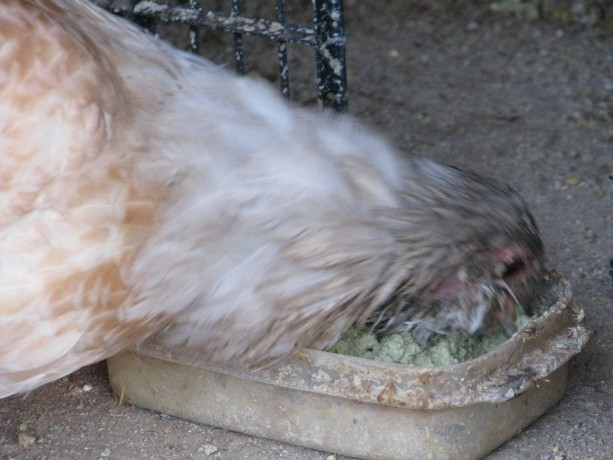
Belle’s eating habits are not a pretty sight. Although what we feed Belle is exactly what we feed the other hens, only wet, they still are jealous and will push her away from her food. So she is fed in a special upside-down milkcrate of my daughter’s design, in the upper portion of the quail coop (the quail won’t go upstairs). The door is closed to just a Belle-sized crack and held open with a sophisticated latching unit (a stick). Even so some of the bolder girls will invade.
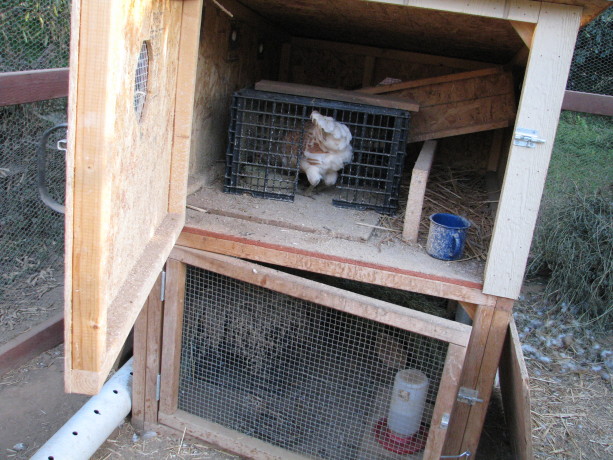
Belle eats upstairs in the quail coop. A crate helps keep her food from being raided by other hens. Some food does go down Belle’s throat, but much of it decorates the crate.
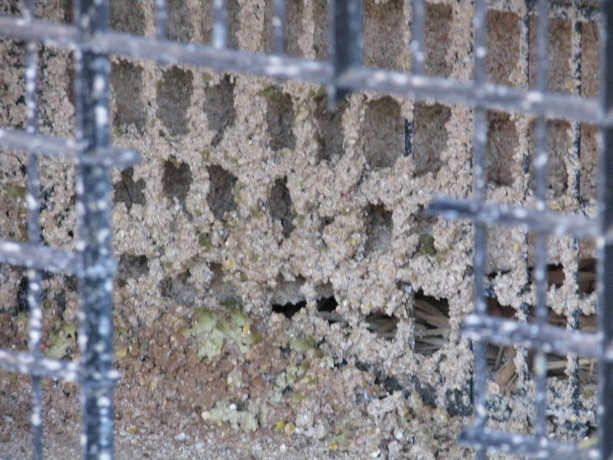
The wall of splatter inside her eating crate. After giving her a bath (as in the top photo) to soak off the dried hen food, her feathers looked so pretty (and she strutted around the porch so much as she dried) that I endeavored to find a solution to keep her clean. Alas, nothing worked. We ended up trimming her neck feathers to reduce the dried clumps.

I tried an old bib of my children’s on Belle to try and protect her clean feathers from splatter. It didn’t work. With all the handling Belle gets she has become a spoiled girl. She lives outside the hen’s pecking order, often scooting under their legs or pushing them out of the way when a treat comes even though she can’t eat it and has to have hers separately.
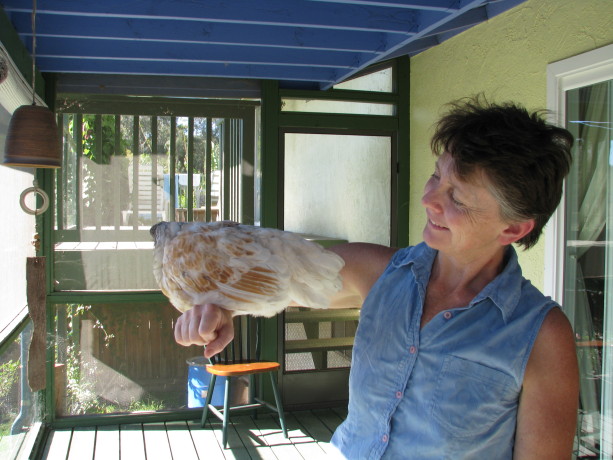
Belle, the falcon. Or the time is quarter-past Belle. Belle likes to help. I usually feed the hens in the morning while in my bathrobe. As I bend to scoop their food I find there is a chicken clawing her way up my back. She enjoys sitting on one’s head as well, particularly on my daughter’s as she has so much hair coiled up that it gives Belle a nice place, albeit an unwelcome one, to perch.
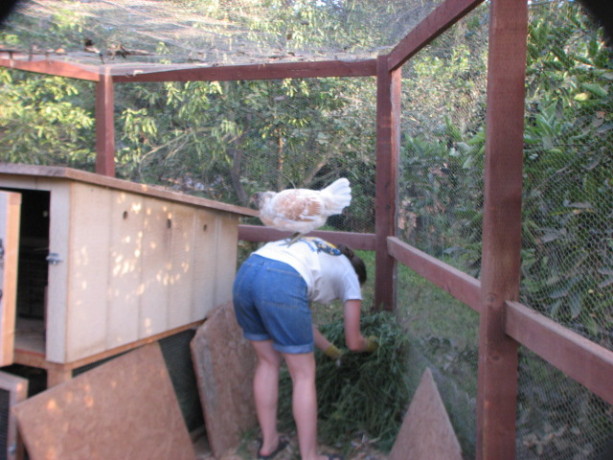
Belle likes to help whenever she can. When we fill Belle’s food dish with water outside the Fowl Fortress, she often sneaks under the door as it is closing and makes a leap for her food. Usually this results in food everywhere but in Belle’s very hungry stomach.

Belle usually can’t wait until she’s served. Belle is a happy chicken, eager for attention and enjoying being ‘teacher’s pet’. She doesn’t mind being carried around like a small football.
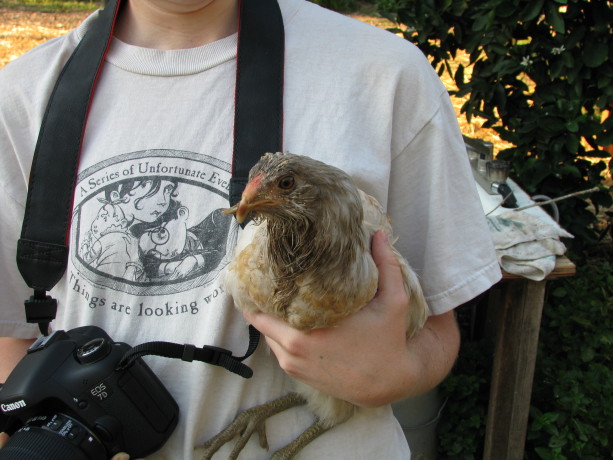
With all the frequent handling she gets, Belle enjoys being carried around… spoiled girl! After making fried zucchini for dinner one night I had extra beaten egg and soy milk left over. On a whim I cooked it into a custard for Belle. Well. I’ve never seen a hen eat so much. It was the perfect consistancy for her to scoop and it was tasty. Giving her a few day’s break I eventually made her a more nutritious custard. In my handy-dandy Vitamix (I really should be paid to sponsor them, although hen custard probably isn’t in their advertising scheme) I mixed quail eggs and their shells, lay pellets, ground cracked corn, oyster shell, buttermilk, and celery greens which I happened to have right there (from home-grown celery). The custard turned out very unappetising.
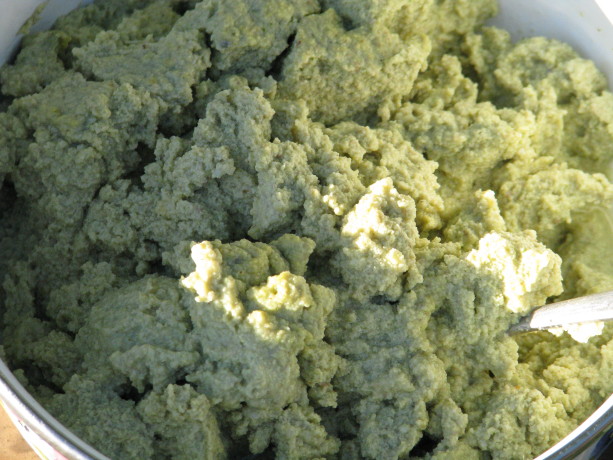
Although it looks like a cross between brocciflower and a sea sponge, it is really a dry custard. Apparently it was only unappealing to me and Miranda.
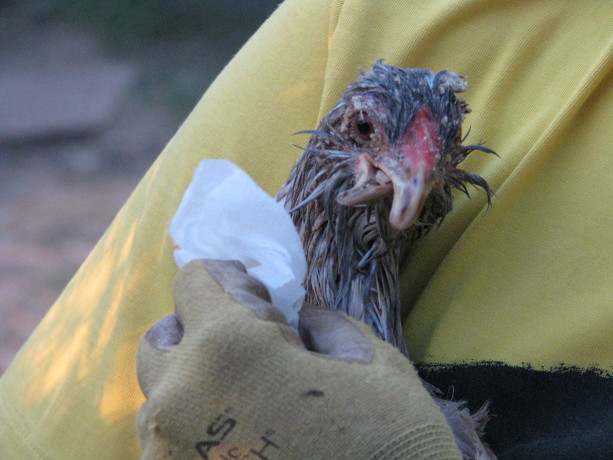
After-custard clean-up is necessary due to the dairy products. Belle’s not happy about being dabbed. It is worth the extra effort to insure Belle has a good meal and a full crop at the end of the day. When she’s full of custard she actually struts around the yard, happy with her fullness and the fact that she had a treat no one else had. Belle is of laying age but her size is smaller than the other hens and she’s still growing. I don’t mind if she doesn’t lay; she’s a darling friend and a neutral hen in the coop. I’m sure Belle will be the source of many more stories and certainly a lot more mess. Just another crazy, high-maintenance, unproductive little animal here at Finch Frolic!
-
Fruit Tree Guild, Revisited
In June I blogged about how to plant a fruit tree guild, and gave the example of one I was planting by the Fowl Fortress. I thought I’d show you how it matured.

Apple tree in trouble: heavy clay thoroughly shot through with Bermuda grass. Yuck! This was the area four months ago. Heavy, sticky clay taken over with Bermuda grass. A struggling apple tree begs for my help. A star jasmine climbs the side of the Fowl Fortress. A portion of the brown subterranean irrigation system lies aboveground.
Using permaculture design, I created a plant guild with herbs and vegetables that would build the soil and help the apple tree.

A guild is planted. Strawberries went around the trunk of the tree for groundcover and grass competition. Comfrey, a valuable nutrient accumulator in there, too, for slash and drop fertilization. There is also a perennial basil, marjoram, gourds, golden runner bean (a nitrogen fixer), garlic chives, a prostrate rosemary and a tomato, along with other flower seeds. This is how it looks now from the same vantage point:
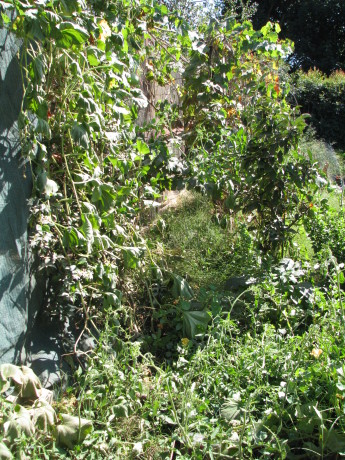
The guild in September. 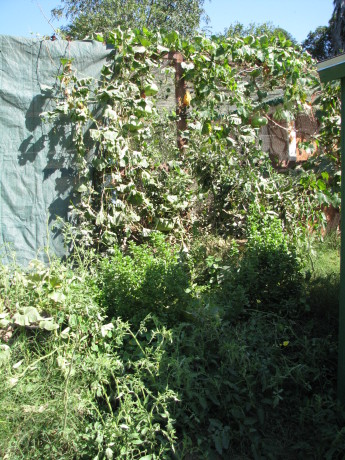
Layers of plants protect the ground and produce food. 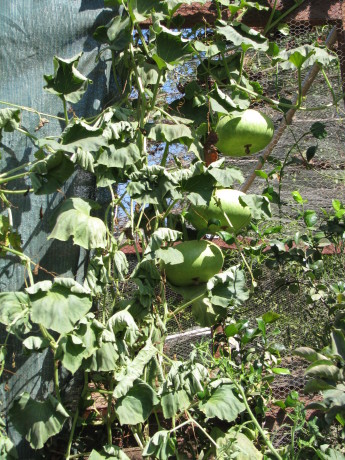
These gourds can be dried and made into bowls. 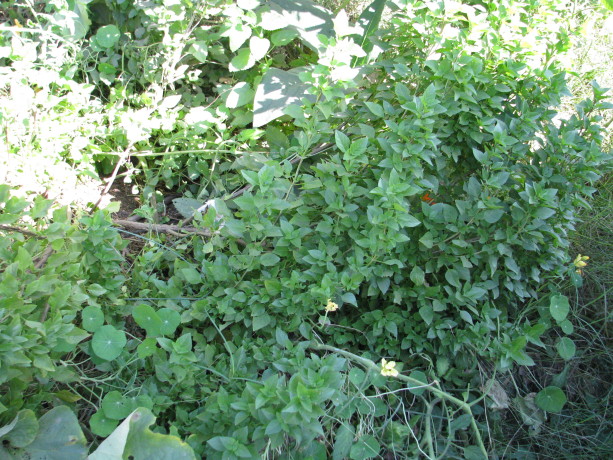
Perennial basil, Amish paste tomatoes smother the weeds and enrich the soil. 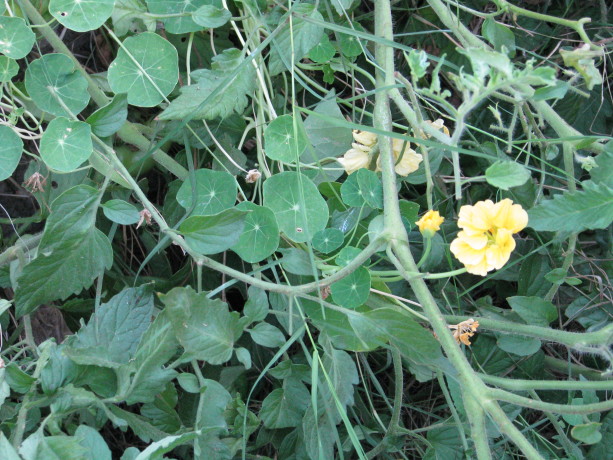
Nasturtiums reseed and fill in as the other vegetables die off. Polyculture beds produce abundant, insect-confusing food guilds which help fertilize and water each other and improve the soil quality. Meanwhile the apple tree has a few apples on it and looks healthier than it has been. Next year’s growth should be drastically improved, and the amount of invasive grasses should be nil. If I don’t grow consecutive annual crops here around the perennial plants, I will sheet mulch the bed.
- Compost, Gardening adventures, Health, Hugelkultur, Other Insects, Permaculture and Edible Forest Gardening Adventures, Soil, Vegetables, Worms
Don’t Clean Up, Dig It In!

Use old vegetables to grow new ones! Tomatoes, eggplant, peppers, fennel, carrots, string beans, three kinds of basil, and probably other things I’ve forgotten about! In January of this year I wrote about Lazy Composting. Frost had killed off sweet potato and tomato vines,
and the soil in the raised garden beds were becoming very low.

- Soil level is very low on the raised beds.
Instead of hauling all the vines to the compost heap or bin, I thought I’d create soil in place. The raised beds are lined with chicken wire to protect veggies from gophers. Although I didn’t want to disturb the microbes and fungus in the soil, I dug out half the beds down to the wire.
Then I layed all those vines right on the soil and covered them up.
Then I did the other half…
- Spent tomato vines, with some green ‘maters still attached.
… and then did the other bed. Any thick stalks in other beds which didn’t need extra soil I simply cut close to the ground so that their roots can decay in place and feed the wormies.
I sprinkled the whole thing with a little Epsom salts for the magnesium sulfate, and a little sugar to start the disturbed microbes feeding and reproducing heavily, which would cause them to decompose the vines more quickly.
In one bed I planted cold weather crops right away; peas, brassicas, garlic, onions and more. I am a firm practicioner of polyculture, or integrated gardening , which means that I plant an assortment of seeds of plants which will help each other in small areas instead of planting all one thing to a bed. I can still plant a row of peas so that I can string them up easily, but I’ll plant all kinds of other plants around them. Usually I don’t plant in a line at all anymore, but rather stake the plants as they need them. Often they’ll use taller plants as support. This is why planting peas and sweet peas next to trees and bushes is a great idea (they fix nitrogen in the soil which helps the tree).
In the other bed I waited to plant until March when the weather warmed up, because I was planting early summer crops. Here it is the beginning of September, and here are the beds, still producing. Even the winter veg one.
In the bed to the right there is a yellow current tomato blocking the view, and growing into the tree. You can see a Japanese eggplant, and behind it the red is a pepper. Under the tomato and along the bed are three kinds of basil, many string bean plants, some of the sweetest carrots we’ve grown, fennel (one of which we allowed to be the host plant for the Anise Swallowtail, which ate the tops. The bottom of the fennel, which is the part we eat, will still be harvestable). In the bed to the right is the January plants still alive and kicking. Collards, kale, garlic, celery, onions, brussels sprouts, kohlrahbi and more. We’ve harvested most of the garlic and onions. We’ve harvested kale, collards and celery by cutting leaves and allowing the plant to continue to grow. The stalks are now so thick that it is hard to cut them. Out of season, these plants have had attack by cabbage moths and other bugs, but because of the integration of plants and the health of the soil, they’ve bounced right back. I’m harvesting the plants now to feed to the chickens so that I can use the bed for something else soon.
So what happened? A teaspoon of great soil has a billion microbes in it, a million fungi, tens of thousands of amebas, bacteria and all kinds of things we don’t even know about yet. This is a good thing. This is the secret to continued life on this planet. Healthy soil doesn’t wash away, doesn’t erode, feeds the underground waterways, grows excellent food for healthy wildlife and healthy humans. If we feed the soil, we save the planet. That simple. That means no Roundup, no GMOs, no chemical (even organic) fertilizer. Just compost. Very cheap and easy.
Vegetables tend to like a soil that is heavier in bacteria than in fungus, although both should be present. Woody plants such as bushes and trees tend to like a more fungal soil. The vines that I buried had both dry (stems) and wet (green leaves and tomatoes) on them. The stems made the fungus flourish in the soil, and the green bits made the bacteria active. There wasn’t enough matter to become anaerobic, or to rob nitrogen from the soil. The vines weren’t compacted so lots of soil surrounded all the parts, aiding in quick composting and keeping the soil aerated. Water could be absorbed better as well.
If you are starting a garden and want to buy compost, be careful of what stores sell you. In August I was asked to look at a few raised beds that hadn’t succeeded. The soil was low in the beds, there were a few straggly pepper plants, a poorly tomato and some brassicas of some sort which were so stunted that they were just green balls of leaves. When I pulled one up there was white stuff on the roots. A couple of strawberry plants looked very healthy but unproductive. I tried the soil and couldn’t get my finger into it because the roots from those poor peppers had made a thick mat just under the surface of the dirt well beyond their dripline. Two major things were wrong. One was the dirt in the beds. Splinters of shredded wood made up the bulk of it. The woman who had asked me to look at the beds said that she had described her project at Home Depot and they’d recommended two kinds of bagged stuff. I say stuff, because it isn’t soil. What they recommended would be appropriate for hardwoods such as bushes and trees, or acid-loving plants. That is why the strawberries were healthy, only they were in the full sun in a searing hot place and would have done much better under the shade of other plants. I showed the white stuff on the brassicas to her; it was fungal net, which showed the high fungal activity in the soil. Perfect for trees, not perfect for vegetables. Also the brassicas are cold-weather plants and just won’t develop in our summer heat here in San Diego County. They should be planted from October through the beginning of March. The spongy soil… honestly, I’ve never before felt root mat so thick that I couldn’t wiggle my finger into the soil… was the result of desperate plants and poor watering. A custodian would occasionally hose water the beds, which meant that he’d shoot some water on them for a few minutes every day or so. This topical water didn’t sink into the bark-heavy soil. It was only enough to water the top, so the plant roots couldn’t go deep. It was often enough that the plants didn’t die entirely, but survived stunted and striving for water and nutrition that the fungal soil wasn’t providing. Vegetables (and roses!); indeed, most plants except grasses and seedlings, need deep watering less frequently. This allows the roots to go where they want to go, deep into the ground where they can mine nutrients and stabilize the plant. My advice for her was to dig in the few plants that were there, use the compost in the compost bin next to the beds, even if it wasn’t decomposed and add some vegetable-friendly soil to the beds to bring up the heighth. I recommended mixing seeds and scattering them, making sure she planted winter crops, not corn or tomatoes. I also recommended a long watering twice a week; none when it starts raining. If it ever does.
Recommending permaculture techniques to people makes me want to work in the garden! That is because there is so much life, so much success, so many happy surprises and such great feelings that come out of naturally planted gardens. Rows of veggies look so neat and peaceful, but beds chock full of veggies are more fun, better tasting and far more productive.
I just wanted to follow up on the old post about digging in the vines and show you how well the plants did. I have never fertilized these beds after burying the vines and sprinkling on the Epsom salts and sugar. All this growth is due to the happy microbes making nutrients available to the vegetable roots. If you think about it, plants in the wild shed their seeds and then either completely die off or drop leaves. The seeds naturally grow up through the debris of the last generation. Makes sense, doesn’t it?
When these beds are done (if they ever are! They keep producing!) I will practice no-dig gardening on them and simply cut all the plants at the soil surface and drop the tops. I’ll plant seeds for winter crops right in among the debris of the summer crops. They’ll use the nutrients, shade and support of the old crops to grow. October is a good planting time for winter crops because the weather finally changes and the daylight hours are shorter which these plants need. What to plant? Potatoes, garlic, onions, Brussels sprouts, cabbage, peas, broccoli, cauliflower, rhubarb, kohlrabi, celery and much more. Cover crops when it frosts and allow good drainage for the potatoes when it rains. Be sure if you buy starter sets that they are guaranteed organic! Best of all plant organic seeds… they do the best of all and are the best value.
Have a happy, easy Fall garden!
- Animals, Bees, Birding, Gardening adventures, Heirloom Plants, Other Insects, Permaculture and Edible Forest Gardening Adventures, Quail, Seeds
Growing Birdseed: Love Lies Bleeding Amaranth
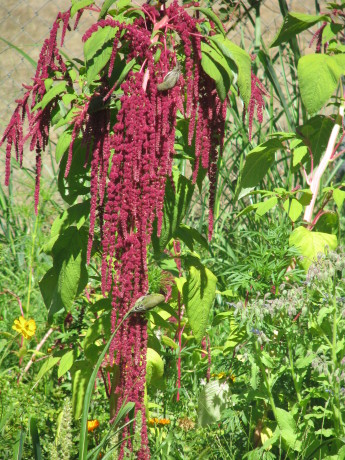
Love-Lies-Bleeding amaranth is a dramatic addition to your garden… ask a bird! We’ve participated in Cornell University’s winter Project Feederwatch for about six years. It is a volunteer amateur scientist-type program where, from November through March, you fill bird feeders and two days a week count how many birds come. Then you report your results on an online form. This helps trace changes in migration patterns and in habitats in wild birds, as well as sitings of diseased birds.
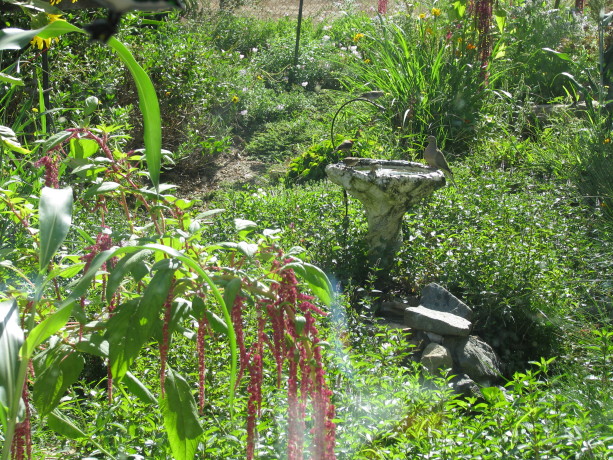
The sound of dripping water attracts birds more than food does… from long distances, too. This year I found out that most birdseed is contaminated by insecticide; some brands are reported to have illegal levels of pesticides in them. Geez! How am I going to get around that problem? I’m not sure about this winter, but I’m going to grow more of my own birdseed. In the past we’ve rolled pine cones in peanut butter and hung them out for woodpeckers and many other birds. I’ve also grown sunflowers, for both their seeds and for their leaves, which lesser goldfinches just love to eat! This year I planted heirloom Love Lies Bleeding Amaranth (Amaranthus caudatus) to some pretty spectacular results. Yes, this is one of the types of amaranth that produces an edible seed for humans; the leaves are edible as well. It can grow 3 -6 feet, with long ruby-red falls of seed heads that the birds just love.
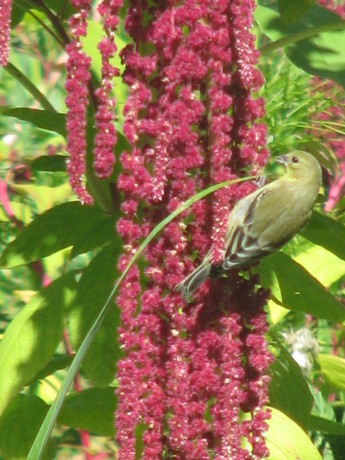
One of our Finch Frolic Finches feeding! There are many other amaranths to grow for both your own consumption as well as for the birds. Sometimes you grow it for yourself and end up feeding the birds! Of course there are many plants which attract hummingbirds all year, especially those with tubular flowers. Why do you want to attract birds? Besides their right to habitat, and their appeal to our better selves, all native animals play important roles in the preditor/prey relationship in a healthy garden. The birds may eat some of your produce, but they are also eating large amounts of bugs. They are also pooping, and you know how valuable poop is to any garden! If you plant a bird garden away from your vegetable crops, then plant your veg crops using the polyculture method, you will have birds and food for yourself as well. Please, please don’t put up those dangerous tree nets! They tear apart your trees when you try to remove them, they don’t really work, and birds can be stuck in them. When they are on the ground snakes are trapped in them! No plastic netting. Ever. Please!
Try planting some amaranth – especially this one with the dramatic name and dramatic fall of color – next spring when you plant a bird garden. Or in your edible forest garden and plant guilds. Or between your fruit trees, or along the back of your flower beds. Take a nibble for yourself if the birds will let you!

